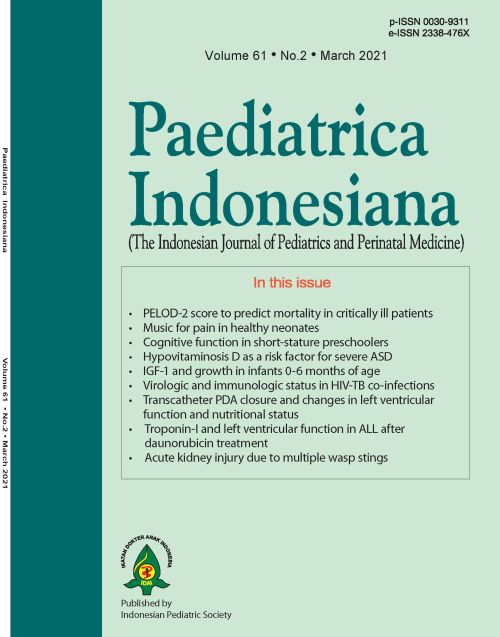Music for pain in healthy neonates
DOI:
https://doi.org/10.14238/pi61.2.2021.69-73Keywords:
music, pain, neonates, NIPSAbstract
Background The neonatal pain threshold is 30-50% lower than in adults and older children because of immature pain inhibition function in nervous centers. Acute pain in neonates results in behavioral, physiological, and cerebral blood flow changes that may lead to intraventricular bleeding and periventricular leukomalacia. Music is believed to reduce pain perception as it distracts, influencing the parasympathetic and sympathetic nervous system by decreasing pulse rate, blood pressure, and breathing, hence, promoting a relaxed state.
Objective To evaluate effects of music intervention on physiological parameters and pain perception in healthy newborns undergoing a painful medical procedure (immunization injection).
Methods This was a double-blind, randomized control trial study. A recorded instrumental lullaby “Nina Bobo†was given for 5 minutes to the music group and no music for control, prior injection of Hepatitis B 0. The evaluation of heart rate and SpO2 were performed at baseline, 30 seconds, and 5 minutes after injection. Pain perception were measured by Neonatal Infant Pain Scale (NIPS) at 30 seconds and 5 minutes after injection.
Results Total of 51 subjects were enrolled. There were no difference of SpO2 and NIPS between both music and control groups. Music improved heart rate after 30 seconds and 5 minutes after injection, median 126 (range 55-149) bpm from median 136 (range 78-154) bpm, and even lower than baseline [mean 128.9 (SD 12.5) bpm; P=0.019]. The control showed no improvement of heart rate mean 124,34 (SD 18,45) from 124,73 (SD 18,39); P=0.875There were no significant differences between the 2 groups.
Conclusion Music is not effective in improving oxygen saturation, heart rate, and is not effective in reducing the degree of pain.
References
2. Witt N, Coynor S, Edwards C, Bradshaw H. A Guide to Pain Assessment and Management in the Neonate. Curr Emerg Hosp Med Rep. 2016;4(1):1-10. doi:10.1007/s40138-016-0089-y.
3. Melo GM de, Lélis ALP de A, Moura AF de, Cardoso MVLML, Silva VM da. Pain assessment scales in newborns: integrative review. Rev paul pediatr. 2014;32(4):395-402. doi:10.1590/S0103-05822014000400017.
4. Hall RW, Anand KJS. Pain Management in Newborns. Clinics in Perinatology. 2014;41(4):895-924. doi:10.1016/j.clp.2014.08.010.
5. Finnerty R. Music Therapy as an Intervention for Pain Perception. Published online 2018. doi:10.13140/RG.2.2.26573.95207
6. Bo LK, Callaghan P. Soothing Pain-Elicited Distress in Chinese Neonates. :7.
7. Joyce BA, Keck JF, Gerkensmeyer J. Evaluation of pain management interventions for neonatal circumcision pain. Journal of Pediatric Health Care. 2001;15(3):105-114. doi:10.1067/mph.2001.110272.
8. Standley JM. Efficacy of music therapy for premature infants in the neonatal intensive care unit: a meta-analysis. Archives of Disease in Childhood - Fetal and Neonatal Edition. 2011;96(Supplement 1):Fa52-Fa52. doi:10.1136/archdischild.2011.300164.118.
9. Hohmann L, Bradt J, Stegemann T, Koelsch S. Effects of music therapy and music-based interventions in the treatment of substance use disorders: A systematic review. Zhang Q, ed. PLoS ONE. 2017;12(11):e0187363. doi:10.1371/journal.pone.0187363.
10. Shabani F, Nayeri N, Karimi R, Zarei K, Chehrazi M. Effects of music therapy on pain responses induced by blood sampling in premature infants: A randomized cross-over trial. Iranian J Nursing Midwifery Res. 2016;21(4):391. doi:10.4103/1735-9066.185581.
11. Tekgündüz KŞ, Polat S, Gürol A, Apay SE. Oral Glucose and Listening to Lullaby to Decrease Pain in Preterm Infants Supported with NCPAP: A Randomized Controlled Trial. Pain Management Nursing. 2019;20(1):54-61. doi:10.1016/j.pmn.2018.04.008.
12. Katz J, Rosenbloom BN. The Golden Anniversary of Melzack and Wall’S Gate Control Theory of Pain: Celebrating 50 Years of Pain Research and Management. Pain Research and Management. 2015;20(6):285-286. doi:10.1155/2015/865487.
13. Ullsten A, Hugoson P, Forsberg M, et al. Efficacy of Live Lullaby Singing During Procedural Pain in Preterm and Term Neonates. 2017;9(2):13.
14. Loewy J. NICU music therapy: song of kin as critical lullaby in research and practice: Rhythm, breath, and lullaby NICU music therapy. Ann NY Acad Sci. 2015;1337(1):178-185. doi:10.1111/nyas.12648.
15. Rossi A, Molinaro A, Savi E, et al. Music reduces pain perception in healthy newborns: A comparison between different music tracks and recoded heartbeat. Early Human Development. 2018;124:7-10. doi:10.1016/j.earlhumdev.2018.07.006.
16. Garunkstiene R, Buinauskiene J, Uloziene I, Markuniene E. Controlled trial of live versus recorded lullabies in preterm infants. Nordic Journal of Music Therapy. 2014;23(1):71-88. doi:10.1080/08098131.2013.809783.
Downloads
Published
How to Cite
Issue
Section
License
Authors who publish with this journal agree to the following terms:
Authors retain copyright and grant the journal right of first publication with the work simultaneously licensed under a Creative Commons Attribution License that allows others to share the work with an acknowledgement of the work's authorship and initial publication in this journal.
Authors are able to enter into separate, additional contractual arrangements for the non-exclusive distribution of the journal's published version of the work (e.g., post it to an institutional repository or publish it in a book), with an acknowledgement of its initial publication in this journal.
Accepted 2021-02-05
Published 2021-02-05


















